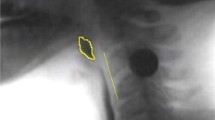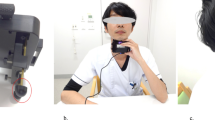Abstract
The purpose of our study was to evaluate whether swallowing maneuvers designed to impact pharyngeal physiology would also impact esophageal physiology. Healthy volunteers underwent high-resolution manometry while performing three randomized swallowing maneuvers with and without a 5-ml bolus: normal swallowing, Mendelsohn maneuver, and effortful swallowing. We examined esophageal parameters of peristaltic swallows, hypotensive or failed swallows (“nonperistaltic swallows”), distal contractile integral (DCI), contractile front velocity (CFV), intrabolus pressure, and transition zone (TZ) defect. Four females and six males (median age 39 years; range 25–53) were included in the study. The overall number of nonperistaltic swallows was 21/40 (53 %) during normal swallowing, 27/40 (66 %) during the Mendelsohn maneuver, and 13/40 (33 %) during effortful swallowing. There were significantly more overall nonperistaltic swallows with the Mendelsohn maneuver compared with effortful swallowing (p = 0.003). While swallowing a 5-ml bolus, there were more nonperistaltic swallows during the Mendelsohn maneuver (12/20, 60 %) compared to that during normal swallowing (6/20, 30 %) (p = 0.05) and more peristaltic swallows during effortful swallowing as compared to Mendelsohn maneuver (p = 0.003). Intrabolus esophageal pressure was greater during the Mendelsohn maneuver swallows in the bolus-swallowing condition as compared to normal swallowing (p = 0.02). There was no statistical difference in DCI, CFV, or TZ defect between swallowing conditions. The Mendelsohn maneuver may result in decreased esophageal peristalsis while effortful swallowing may improve esophageal peristalsis. Because it is important to understand the implications for the entire swallowing mechanism when considering retraining techniques for our patients, further investigation is warranted.








Similar content being viewed by others
References
Hoshino M, Sundaram A, Srinivasan A, et al. The relationship between dysphagia, pump function, and lower esophageal sphincter pressures on high resolution manometry. J Gastrointest Surg. 2012;16(3):495–502.
Smout A, Fox M. Weak and absent peristalsis. Neurogastroenterol Motil. 2012;24(Suppl 1):40–7.
Bülow M, Olsson R, Ekberg O. Videomanometric analysis of supraglottic swallow, effortful swallow, and chin tuck in healthy volunteers. Dysphagia. 1999;14(2):67–72.
Hoffman MR, Mielens JD, Ciucci MR, Jones CA, Jiang JJ, McCulloch TM. High-resolution manometry of pharyngeal swallow pressure events associated with effortful swallow and the Mendelsohn maneuver. Dysphagia. 2012;27(3):418–26.
McCulloch TM, Hoffman MR, Ciucci MR. High-resolution manometry of pharyngeal swallow pressure events associated with head turn and chin tuck. Ann Otol Rhinol Laryngol. 2010;119(6):369–76.
Takasaki K, Umeki H, Hara M, Kumagami H, Takahashi H. Influence of effortful swallow on pharyngeal pressure: evaluation using a high-resolution manometry. Otolaryngol Head Neck Surg. 2011;144(1):16–20.
Umeki H, Takasaki K, Enatsu K, et al. Effects of a tongue-holding maneuver during swallowing evaluated by high-resolution manometry. Otolaryngol Head Neck Surg. 2009;141(1):119–22.
Takasaki K, Umeki H, Kumagami H, Takahashi H. Influence of head rotation on upper esophageal sphincter pressure evaluated by high-resolution manometry system. Otolaryngol Head Neck Surg. 2010;142(2):214–7.
Lever TE, Cox KT, Holbert D, Shahrier M, Hough M, Kelley-Salamon K. The effect of an effortful swallow on the normal adult esophagus. Dysphagia. 2007;22(4):312–25.
Butler S, Nekl C, Rees C, Leng I, Lever T. Effects of effortful swallow on esophageal peristalsis in healthy adults [abstract]. Dysphagia. 2011;46:440.
Martin-Harris B, Michel Y, Castell D. Physiologic model of oropharyngeal swallowing revisited. Otolaryngol Head Neck Surg. 2005;133:234–40.
Pandolfino JE, Fox MR, Bredenoord AJ, Kahrilas PJ. High-resolution manometry in clinical practice: utilizing pressure topography to classify oesophageal motility abnormalities. Neurogastroenterol Motil. 2009;21:796–806.
Ayazi S, Crookes P. High-resolution esophageal manometry: using technical advances for clinical advantages. J Gastrointest Surg. 2010;14(Suppl 1):S24–32.
Huckabee ML, Steele CM. An analysis of lingual contribution to submental surface electromyographic measures and pharyngeal pressure during effortful swallowing. Arch Phys Med Rehabil. 2006;87(8):1067–72.
Xiao Y, Read A, Nicodème F, Roman S, Kahrilas PJ, Pandolfino JE. The effect of a sitting vs supine posture on normative esophageal pressure topography metrics and Chicago classification diagnosis of esophageal motility disorders. Neurogastroenterol Motil. 2012;24(10):509–16.
Pandolfino JE, Ghosh SK, Rice J, Clarke JO, Kwiatek MA, Kahrilas PJ. Classifying esophageal motility by pressure topography characteristics: a study of 400 patients and 75 controls. Am J Gastroenterol. 2008;103:27–37.
Bulsiewicz WJ, Kahrilas PH, Kwiatek MA, et al. Esophageal pressure topography criteria indicative of incomplete bolus clearance: a study using high-resolution impedance manometry. Am J Gastroenterol. 2009;104:2721–8.
Johnson PE, Belafsky PC, Postma GN. Topical nasal anesthesia and laryngopharyngeal sensory testing: a prospective, double-blind crossover study. Ann Otol Rhinol Laryngol. 2003;112:14–6.
Kamarunas EE, McCullough GH, Guidry TJ, Mennemeier M, Schluterman K. Effects of topical nasal anesthetic on fiberoptic endoscopic examination of swallowing with sensory testing (FEESST). Dysphagia. 2013;. doi:10.1007/s00455-013-9473-x.
Walsh J, Branski RC, Verdolini K. Double-blind study on the effects of topical anesthesia on laryngeal secretions. J Voice. 2006;20(2):282–90.
Rubin AD, Shah A, Moyer CA, Johns MM. The effect of topical anesthesia on vocal fold motion. J Voice. 2009;23(1):129–31.
Disclosures
The authors declare that they have no conflicts of interest. A generous grant was provided by Atos Medical Inc for the implementation of this project.
Author information
Authors and Affiliations
Corresponding author
Rights and permissions
About this article
Cite this article
O’Rourke, A., Morgan, L.B., Coss-Adame, E. et al. The Effect of Voluntary Pharyngeal Swallowing Maneuvers on Esophageal Swallowing Physiology. Dysphagia 29, 262–268 (2014). https://doi.org/10.1007/s00455-013-9505-6
Received:
Accepted:
Published:
Issue Date:
DOI: https://doi.org/10.1007/s00455-013-9505-6




